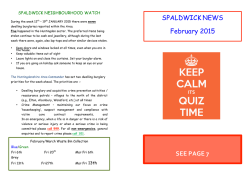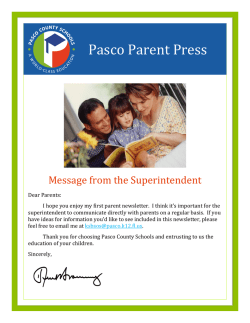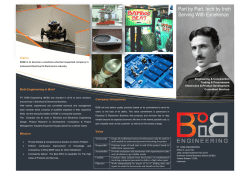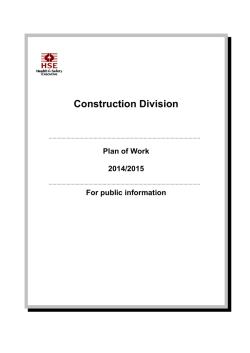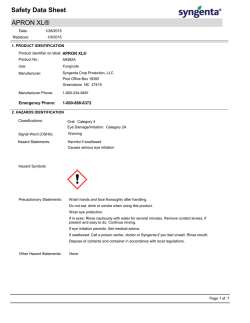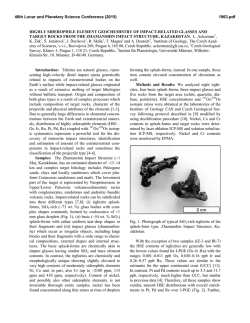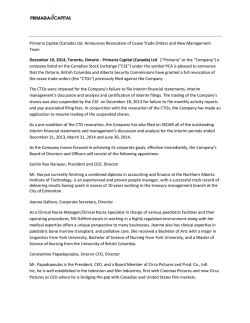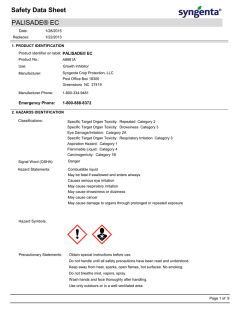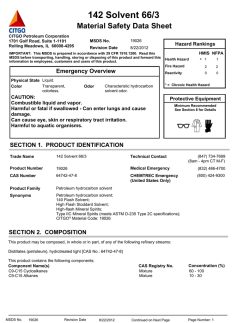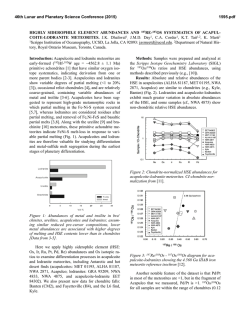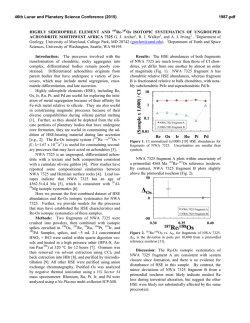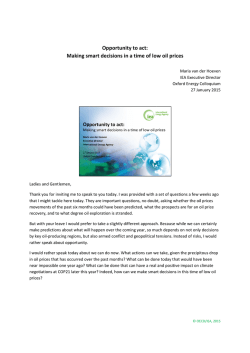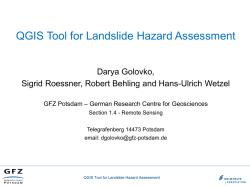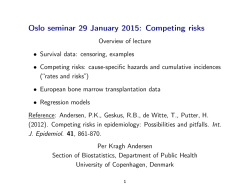
BOBI E Eng gin ne eri ing g
m Lorem Ipsum BO OBI E Eng gin neeriing g Saffety and d Rissk Maanag gem mentt Serrvicees m Ipsum Lorem 2 BOBI E Engineering is an engineering consultancy with p process safety and rissk managem ment services that providees experiencee and experttise in undertaking safeety and risk e engineering studies that enable our make modifications and e enhance their clientss to effectiveely operate, m facilities whilst maaintaining reg gulatory com mpliance and d meeting ments. compaany requirem BO OBI Engin neering’s process safety an nd risk m management team m consistss of highlly qu ualified engineers and specialists. W We offer effectivee risk identificatio on, asssessment and mittigation aadvice to o our custtomers. Every project, largge or small, co omplex or sim mple, involves rrisk. Riskks can occur att any point in a project and it is essential that theyy are identified early on, asssessed, monittored and effeectively managged throughou ut the project lifecycle. Ado opting a risk m management approach to evvery solution w we deliver to custom mers, BOBI Enggineering is committed to uph holding safety,, managing risks systematically and providing indeependent and tailor‐made aassessments. W We specialize in the effective iden ntification and d control of commercial, pro oject and safety risks and system failures. We provide supports to safety engineering in oil and gas ustry for both onshore and offshore activvities; as well aas in indu geothermal, petro d power indusstries. We iden ntify ochemical and d can hazaards starting ffrom the feasibility and desiign stages and continue evaluatiing associated d risks related to the operation of faacilities. Our tteam managess risk by evaluating failure prob bability and seeverity in ordeer to eliminatee or reduce rissk to acceeptable levels. This requires the ssound analysiss of number o of variables thaat could lead to a hazardous event, including mechanical failu ure, environmental efffects and hum man error; as w well as the usee of provven method to o ensure a con nsistent and reeliable way of reacching safety logic. Our team is able tto assist customers in achievving world‐claass standards in techn nology qualificcation and deployment. Wee integgrate technolo ogy qualificatiion into the bu usiness processs of our ccustomers, deelivering tools and processees to enable prroject own ners to effectivvely manage the risks associated with intro oducing, enabling or enhanccing technologgies. With h our team’s d deep technicall knowledge and experiencee, BOB BI Engineering’’s process safeety and risk management teeam is able to interpret aand satisfy num merical safetyy targets as weell as providing solu utions that offeer satissfy appropriate legislation, p real value to custo omers. m Ipsum Lorem 3 Wee undersstand thee implicattions of tthe key isssues across the industry vvalue chaain and, depen nding on the clien nt need, aaddress tthem from a strattegic and d tactical f services we provvide. levvel, usingg a blend of skills and expeerience from the range of The key challengees found in reccent industriees include: Rapidly evvolving techno ology step outss which are requiring aadvanced asseessment techn niques Ongoing o operational chaallenges of an n ever increasing n of aging facilities that requ uire life population extensionss and upgradees Shortage o of skilled resou urces, particularly in major hazard riskk managemen nt Limited tools and bench hmarking techniques to nd measure w workforce effectivelyy undertake an engagemeent in relation to the managgement of operationaal health, safeety and environmental issuees Organizational ability to o effectively in ntegrate corporate and cross industry practicees and leadership The Safety and Risk Managemeent team combines our onal service deelivery modelss to consultancy skills and professio support business,, engineering design, operational integritty ment. This app proach deliverrs a competitivve and risk managem ng complexityy, edge whereby efffectively manaaging increasin uncertainty and cchange within customers’ business and engineering delivvery needs. BI Engineeringg Safety and Riisk Managemeent services BOB rangge from the trraditional asseessment of riskk and input intto the design and op peration of up pstream and downstream oiil and gas, geotherm mal, petrochemical and pow wer industriess, to We the growing areass of human factors and safeety culture. W h our customers and their teeams to identiify, worrk closely with asseess and reducee risk and therreby maximizee competitive advaantage. BOBI Engineeering offers Saffety and Risk Management services as follows: Hazard d Identification (HAZID) Study Hazard d and Operabiility (HAZOP) SStudy Quantitative Risk Asssessment (QR RA) Conseq quence Modeelling and Anallysis Safety Integrity Leveel (SIL) Study of Protection A A) Layer o Analysis (LOPA Fire an nd Explosion R Risk Analysis (FFERA) Non‐H Hydrocarbon H Hazard Analysis (NHHA) Health h, Safety and EEnvironmental (HSE) Case Hazard d Register Flare R Radiation Stud dy Hazard dous Area Classsification Fire Prrotection Stud dy Risk Asssessment Traaining Processs Safety Manaagement Audit Safety Critical Elemeent (SCE) and Performance Standaard Human n Factor Engin neering (HFE) Loss Prevention Study. Identtifying and assessing pottential risks a and hazards a are critical att everyy stage of the project lifeecycle. m Ipsum Lorem 4 B BOBI Engineering haas the cap pability in tthe d development robusst risk‐baseed aassessmen nt supportt methodss. These aaddress haazard iden ntification,, cconsequen nce assesssment, likeelihood eestimation n and risk‐‐based deccision ssupport. R Risk‐based d processes deliver w well b beyond co ompliance requirem ments, and o often at leess overall life‐cycle cost through iinnovativee solutionss. O Our team brin ngs together co ompetence an nd a wide rangge of d disciplines to aassist in criticaal decision pro ocesses. TThroughout alll stages of an investment, ffrom idea cconception an nd concept selection, design n and operatio on to d decommission ning and recyccling, customeers demand that rrisks are undeerstood and efffectively managed. While p primarily focused on the asssessment of risk to personn nel, sstudies can no ormally be exttended to asseet financial risks aassociated witth asset damaage and loss off production. W We recognize the need for ccost‐effective risk managem ment aand draw on o our team expeerience and ou ur integrated sservices to deliver value to our clients. Byy providing a rrange o of tailored con nsequence asssessment prin nciples and ttechniques, w we enable our cclients to understand their tthreats and op pportunities. TThese include: Risk‐based A Assessment Risk‐based s R upport allow ws risks to bee evaluated i in a structure ed manner co onsidering feeasible e events, cons equences an nd likelihoods and a allows priorit tizing risks in n a manner t hat m maximizes ri isk reduction n at economic cost and m meets regula atory requireements wherre a applicable. Identifiication of hazaards An und derstanding off business perfformance from m the perspective of risk exxposures Quantification of con nsequences an nd risks nding of risk drrivers Increassed understan Engineering decision n support to deetermine optimum solutions for modificcations Identifiication of costt‐effective riskk reduction measurres The traansfer of lesso on learned from m other indusstries and companies O Our team usess suitable metthods and a m mixture of in‐ho ouse aand industry‐sstandard modeling tools to analyze problems tto a depth thaat matches theeir potential riisk and complexity. m Ipsum Lorem 5 W With ourr team’s eextensivee kknowledgge of riskk quantification, w which go oes beyon nd just lo ooking at tthe assesssment frrom a pu urely desiign sstandpoint but is also inco orporatin ng o operational and m managem ment facttors tto comm municate a realistic risk p picture. Q Quantitative R Risk Assessment (QRA) mayy be a requirem ment o of applicable legislation and d/or internal ccompany ggovernance to o show that rissks are identiffied and controlled tto an acceptab ble level. The criteria may b be defined by local rregulations orr company or iinvestor policyy. TTypically, a QR RA can be defiined as the formal and ssystematic approach of iden ntifying poten ntially hazardo ous eevents, estimaating the likeliihood and con nsequences off tthose events, and expressin ng the results as risk to peop ple, eenvironment o or the businesss. O Our capabilitiees are supportted with indusstry‐recognizeed ssoftware and ttechnology, enabling us to quantify risk aand aassist compan nies in making sound safety and managem ment d decisions. TThe demonstrration of accep ptable risk levvels is almost rrequired in order for major hazard constrruction plans tto m move forward d. This includes transmission n pipelines, oil, gas aand chemical storage facilities and process plants and o offshore platfo orms, which m may have impaact in the urbaan eenvironment. Quanttitativve Riskk A Asses sment QRA is a form Q malized speccialist metho od for c calculating in ndividual, en nvironmental, e employee an nd public riskk levels for co omparison w with regulato ory risk criteria. B BOBI Engineerring team is ab ble to identifyy hazards and eevaluate the aassociated riskks of these devvelopments byy cconducting QR RA. With our tteam’s extensive knowledgee of rrisk quantificaation, which go oes beyond ju ust looking at tthe aassessment from a purely d design standpo oint but is also o iincorporating operational and managemeent factors to ccommunicate a realistic riskk picture. This also includes p presenting applicable and ccost appropriate solutions to o p potential risk sscenarios. m Ipsum Lorem 6 EEvery com mpany has a management ssystem. TThe challeenge is to develop, iimplemen nt, review w and imp prove ssystems tto enhancce businesss p performaance and aalign to developingg iindustry n norms. Ou ur system ms iincorporaate curren nt best prractices an nd aalign safeety, enviro onment and quality o objectives. TThe clients’ bu usiness perforrmance can im mprove year‐on‐ yyear by enhan ncing the manaagement systeems and explo oiting tthe experiencee. All management systemss should contaain ssound strategic and tacticall planning funcctions, aaccompanied by appropriatte reviews thaat measure pro ogress aand adjust to continual imp provement. O Our team strivves for excelleence in company culture and d b behavior, as th hese are vital to optimize m management p performance. We use behavvioral program mmes to facilittate tthis process. U Using proven risk methodollogies, we work to identify aand eevaluate oppo ortunities and threats. Priorritized risk pro ofiles aare used to ideentify key pro ocesses in the existing m management system, so thaat resources ccan be refocussed on ccritical processes and control activities. R Responsibilities are d defined and co ommunicated d through policcies, expectations, p procedures, practices, ruless and training programmes, self‐ aassessment an nd audit tools. Manageement System ms and Perform mance M Measurees The manageement system T ms and perfo ormance m measures se rvice shares best practicees for HSE m managemen nt using a glo obally acceptted t template and d allows facilities to measure the c customers’ p performance. Areas of i improvemen nt are indicatted along witth s suggested m means to achiieve the improvement. P Performance sstandards sho ould be risk‐baased in order tto ffocus management’s effortss on the featu ures of your o operations wh here the hazarrd potential is greatest. Ourr team w will help the cclients to deveelop these stan ndards and prepare ssystems both to maintain th hem and demonstrate this p performance. At the very leeast, all organiizations must ffollow applicable legislativee and industriaal HSE standarrds. W We can help the clients to identify these requirementss, and d demonstrate ccompliance with specific naational and iinternational rrequirements. Lorem Ipsum 7 BOBI Engineering’s Safety and Risk Management team delivers an extensive range of capabilities in the provision of risk management consultancy services. These services are provided to a wide range of industries, including oil and gas (onshore and offshore), petrochemical and power generation. Hazard Identification (HAZID) Study Hazard Identification (HAZID) Study is a tool for hazard identification, used early in a project lifecycle. The method is a design‐enabling tool, acting to help organize the HSE deliverables in a project. The structured brainstorming technique typically involves designer and client personnel engineering disciplines, project management, commissioning and operations. Major findings and hazard ratings help to deliver HSE compliance, and form part of the project Risk Register required by many licensing authorities. Hazard and Operability (HAZOP) Study The Hazard and Operability (HAZOP) Study is an effective design review method widely used for managing hazard and operability issues. Modern society relies on complex processes to produce the materials, products and services. The public demands such processes to be safe and reliable, and such requirements are enforced through stringent legislation. Our team assists customers in undertaking HAZOP studies. Outputs from the HAZOP events are vital to putting forth sound recommendations of risk based control measures to ensure that vulnerabilities are either eliminated or that risks are lowered to acceptable level. Consequence Analysis and Modeling Our team has extensive consequence analysis knowledge utilizing the latest modeling techniques to obtain accurate models predicting the behavior of gas dispersion, fire and explosions to aid in design and operational studies, and/or decision‐making. Health, Safety and Environmental (HSE) Case HSE Cases are summary documents which detail the Technical Risk Management aspects which are in place for the facilities and assessment of the overall adequacy of the facilities with respect to risk being ALARP. HSE Cases are documents that should be updated throughout the entire lifecycle of the facility, in line with specific regulations and corporate standards. Safety Integrity Level (SIL) Study The assessment of a safety function’s Safety Integrity Level (SIL) or Instrument Protective Function (IPF) provides a measure of the consequences of its failure on the system or equipment’s safety, implications for the surrounding environment and also the potential financial implications on the operating company. Our team can support the clients with both qualitative and quantitative SIL assessments of safety‐instrumented systems. We are also experienced in the use of fault and event tree analysis to provide design solutions to achieve SIL ratings and achieve acceptable equipment and system reliabilities. m Ipsum Lorem BO OBI Eng gineering Jalaan A Raya no. 11, Kartini, Saawah Besar Cen ntral Jakarta, Indonesia 107750 ww ww.bobiengineeering.com ben nny@bobieng gineering.com m iqb [email protected]
© Copyright 2025

